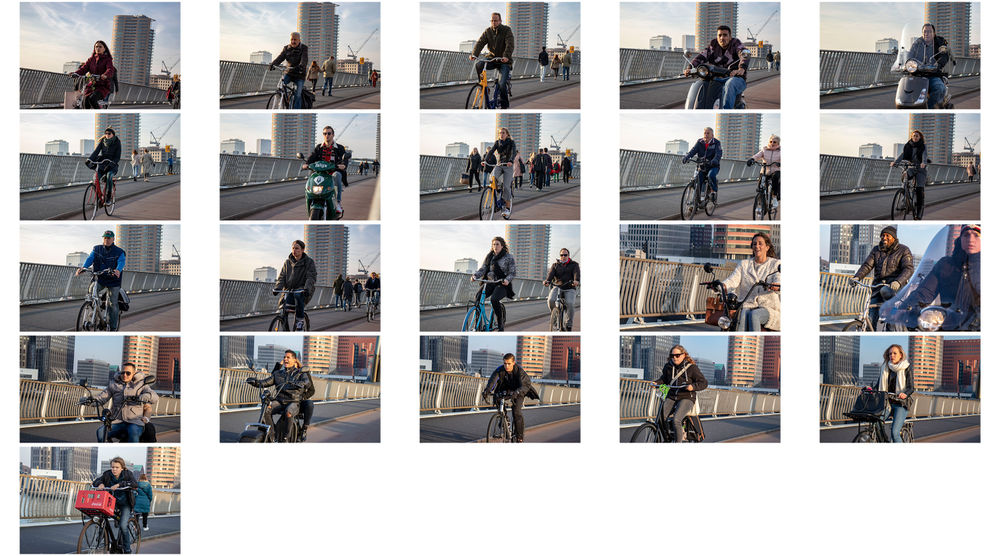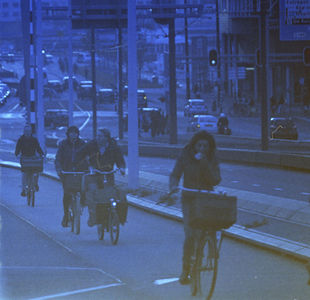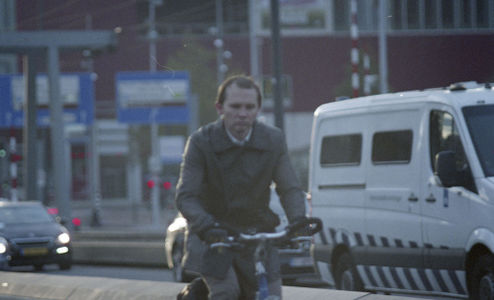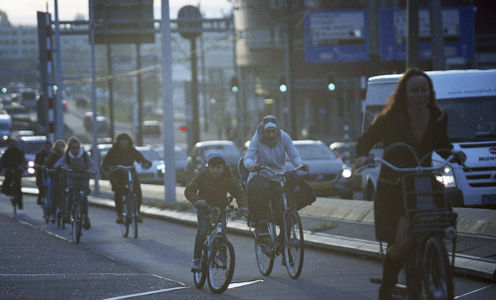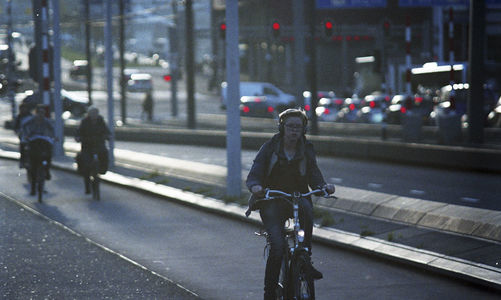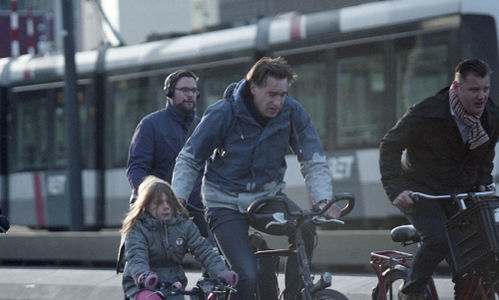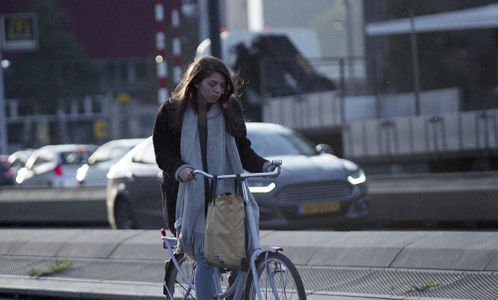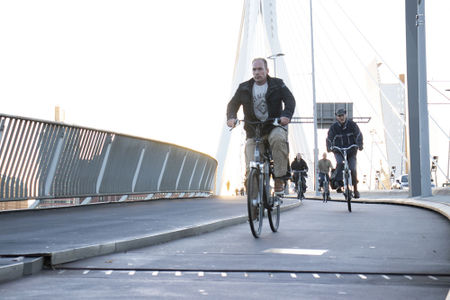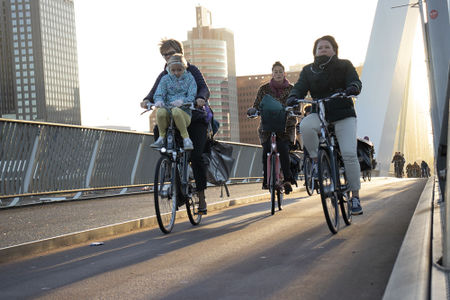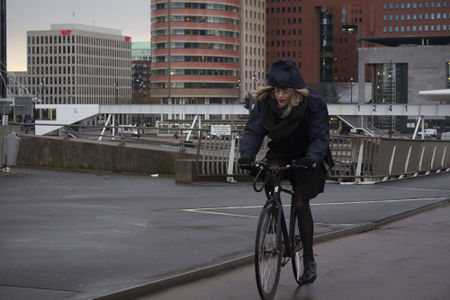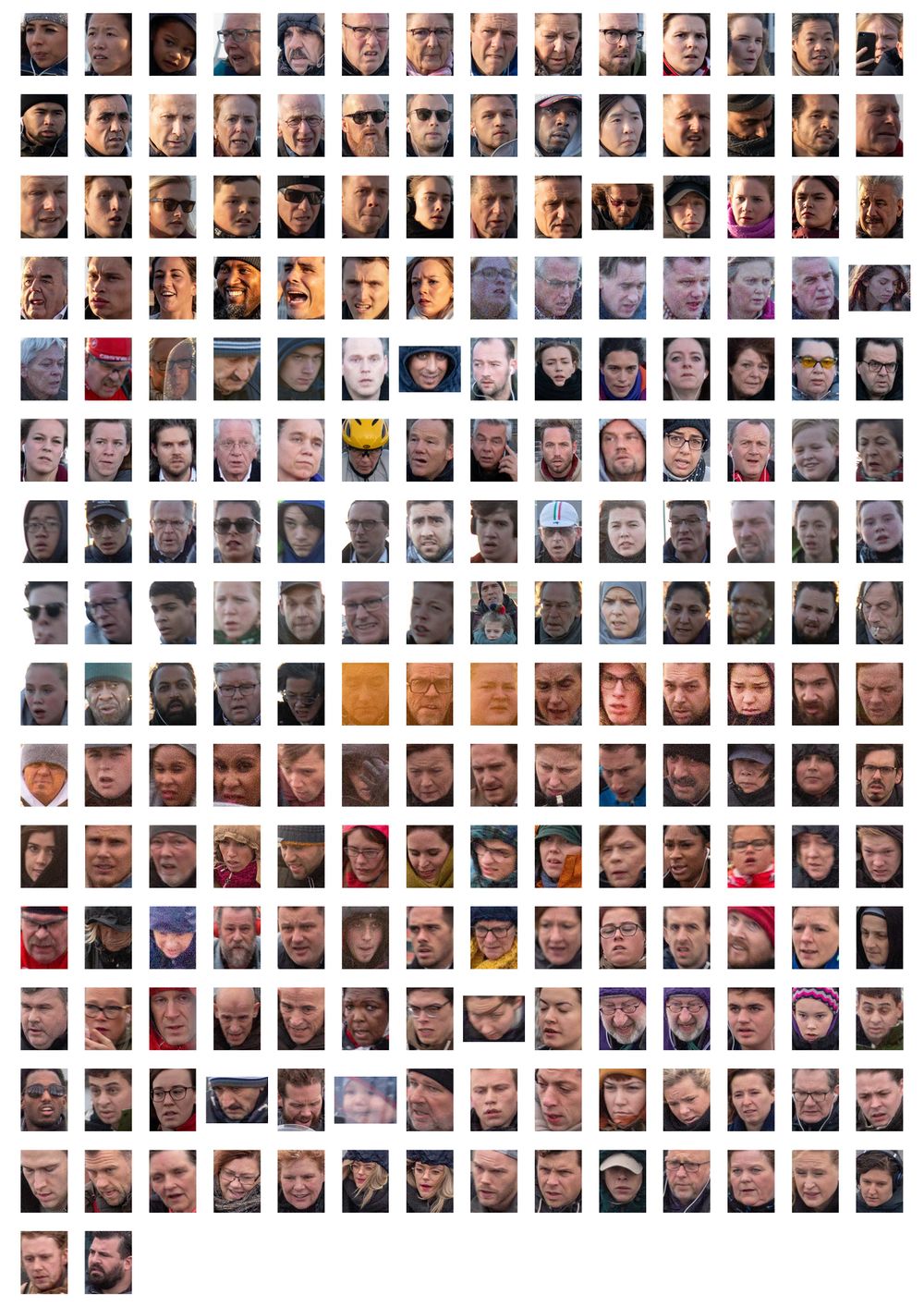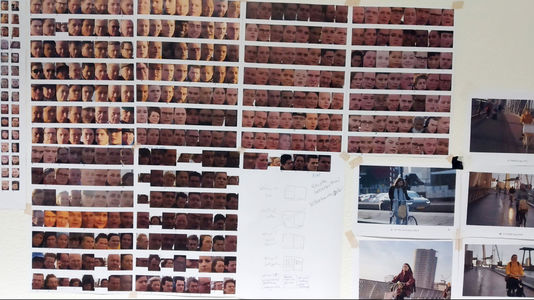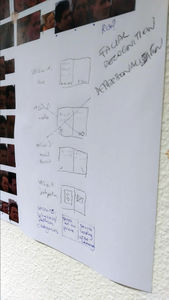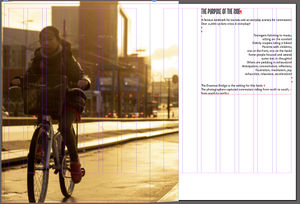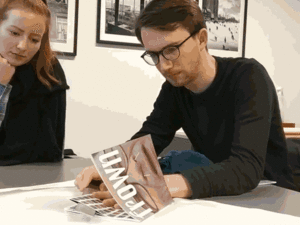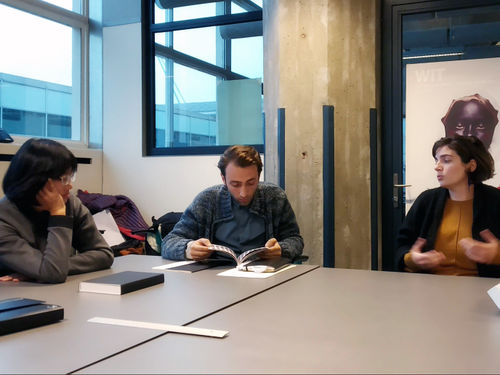Commuters of Erasmusbrug: Difference between revisions
No edit summary |
(→Design) |
||
| Line 88: | Line 88: | ||
On the back of the book the back of a head is shown. This is the only time that we can see a cyclist from the back and rounds out the book. | On the back of the book the back of a head is shown. This is the only time that we can see a cyclist from the back and rounds out the book. | ||
The book layout has a margin of 5 mm on the top, 15 mm on the inside, 30 mm on the bottom to have space for your finger while browsing through the book and 5 mm on the outside. The grid itself consists of 7 columns, like shown in the picture: <br /> | |||
[[File:Photobook Commuters 2018-12-03.jpg|frameless]] | |||
==Text== | ==Text== | ||
Revision as of 13:04, 3 December 2018
Commuters of Erasmusbridge (working title) is a photo series, depicting portraits of cyclists and people who ride their scooters over the Erasmusbridge. The photo series is a collaborative work with Susanna Fasciolo.
Initial idea
The people will be photographed on two positions of the Erasmusbridge on two or three times of the day. The first position will be on the ascent of the Erasmusbridge (it does not matter which end of the bridge). Position number two shall be after the ascension, when the commuters can go idle/freewheel on their two-wheeler. The series is set to be shot on the morning commute around 8am and on the evening at approximately 4-6pm (since the sun is setting already at 5pm in November, the decision still has to be made, if we want to use a flash as an additional light source or only want to rely on the sunlight at 4-5pm). The photographer shall remain hidden to not distract the subjects, keeping them act unaltered and authentic.
The Erasmusbridge - on one hand - is a famous photo motif for tourists and - on the other hand - an important landmark for everyday commuters. Since it is connecting the north and south parts of Rotterdam it attracted about 11,647 cyclists every day [1] in 2017. There is a remarkable variety of people cycling, of all ages and from all walks of life. There are young people listening to music while sitting on the scooter, old couples riding e-bikes. There are parents with their kids, sometimes one on the front, one on the back. Some people are very focused and aware of their surrounding, some lost in thoughts and others are pedaling in exhaustion. The outfits, cycling gear, emotions (anticipation, concentration, self-attention, reflection, meditation, joy, etc.), physical fitness (exhaustion, relaxation, speeding etc.) of the person on the two-wheeler shall let the viewer make assumptions about the purpose of the ride. The photo series - sometimes even in a humorous way - shall leave disclosed, whether the depicted persons are getting to work or school, going out for a night on the town, transporting goods, bringing children to kindergarten, just going for a ride and so on.
First shoot
Shot on 4th of November at approximately 5pm.
Second shoot
Shot on 6th of November between 8 and 9am.
To get a closer look at the person, we thought that it would be nice to have either a good Telelens to better hide from the cyclists and not have them look at the camera. OR to use a full-frame camera to have the ability to crop to the faces without much loss of quality. Since the rental „only“ (in quotation marks, since it is a fairly good camera) is offering entry-level cameras like the EOS 800D or 700D with the Kit-Lens (18-55mm) and does not offer any lenses beyond the Kit, we had to come up with a solution of using our available equipment. That is why I wanted to give my analogue gear a try – since I have a 200mm lens for my Minolta XG-1.
Tryout with a 200mm lens on the Minolta XG-1:
Eventually I had difficulties with the focusing. Due to the relatively fast movement of the people half the photos were out of focus. After all, this series perfectly displays that with a telelens the photographer can hide better, but the focus is too much of a problem.
Third shoot
Shot on 8th of November between 7:45am and 8:45am.
We were still experimenting with positioning ourselves and found a nice spot to hide. By being there at sunrise we were also rewarded with golden light peaking through the bridge structure.
Fourth shoot
Shot on 13th of November between 8 and 9am.
We finally ended up having worse weather. Due to the rain the people were much more bothered by the weather and therefore have much more intense facial expressions.
Zooming further in
After having several conversations (group crit, talking to David, personal talks) we decided to try cropping the images to just the faces under the working title „pain and release“. The concept shall be to not show the bridge or the bicycles and just concentrate on the expressions.
The Photobook
Overall concept
Susanna and I were discussing various ways on how to present the images in a photobook. We had four specific variations in mind:
- sorting all pictures by its creation time
- sorting all pictures by weather influences
- sorting the pictures to the ascend and descend
- sorting them through categories, or behaviour patterns, for example „people on the phone“, „people looking into the camera“, and so on
Over the time we realised that it would help the design process to write down what we want to communicate with the book in one or two sentences. This shall help deciding on design choices like the size of the book, presentation of the photos in the book, texts and much more.
The photobook shall cover the broad variety of facial expressions throughout our time documenting the cyclists of the Erasmusbridge.
Design
We decided to print the book in the dimensions of 160x215mm, which is a little bit wider than DinA5. This way the book is very handy and easy to print.
The cover is showing an enlarged face of a cyclist. In this crop one can see the face of exhaustment. The comedic cover shall raise curiosity for the content. While going through the book the first time, the actual topic is not being revealed. You can only see the cropped faces in a grid of 7 x 8 photos per page. The book is bound with a glue-binding and every page actually consists of two pages (similar to the japanese binding) that are folded, perforated and can – ultimately – be opened on the perforation. We wanted the reader to first make assumptions on where these photos could have been taken. Have all these people been in one big crowd? Are they at a demonstration? Only by opening the perforation on each page one can find out more about the scene. The first opened page has a short introduction text (see below). The other pages – that can be opened – are depicting cyclists in a bigger, panoramic view. Each photo is covering a whole spread, eventually juxtaposing the other pages with its grids and small photos.
On the back of the book the back of a head is shown. This is the only time that we can see a cyclist from the back and rounds out the book.
The book layout has a margin of 5 mm on the top, 15 mm on the inside, 30 mm on the bottom to have space for your finger while browsing through the book and 5 mm on the outside. The grid itself consists of 7 columns, like shown in the picture:
Text
The first opened page has a short introduction text:
The purpose of the ride
A famous landmark for tourists and an everyday scenery for commuters. Over 11,000 cyclists cross it everyday.
Teenagers listening to music,
sitting on the scooter.
Elderly couples riding e-bikes.
Parents with children,
one on the front, one on the back.
Some people focused and aware,
some lost in thoughts.
Others are pedaling in exhaustion.
Anticipation, concentration, reflection,
frustration, meditation, joy,
exhaustion, relaxation, acceleration.
The Erasmus Bridge is the setting for this book. The photographers captured commuters riding from north to south, from south to north.
Thoughts
Thoughts from and with Barend
I did the experiment of not telling Barend at first what the project is precisely about. Instead I showed him contact sheets of the various cropped faces of the commuters. His first thought was that it may be a crowd at an demonstration or at a sports event. He is suggesting to try out various ways of sorting the pictures in the photo book. Either sort it by time (and write down the time on the according pages), or by weather (for example by showing a weather icon), or by ascent and descent. He also suggested to document the work in progress and not only what might work for us in the end. Besides that he asked if the landscape-orientation (crop) is actually working so good in the mass of all pictures, since the overall majority has the portrait-orientation. Furthermore we might try to juxtapose several faces with something connected to the bridge, but without showing the commuters/cyclists again.
Inspiration:
Various facial expressions that Messerschmidt depicted on his portrait sculptures. Not necessarily connected to this project, but good to keep in the back of the head. Paula Winkler took photos of the faces the models in the moment they were told that they are the „Miss World“. She captured the moment by photographing the TV since it was being live casted. See the photo series here: http://www.paulawinkler.com/worldpeace/
Outlook
I would like to continue on this photo series with better digital equipment (meaning: a Tele-Lens). In terms of the photobook Susanna and I were also talking about giving each photo a whole page and placing a closeup of several spots of the bridge on the other page of each spread. The closeup shall for example show the concrete with its sometimes sparkling appearance, the cycle track or other spots. With this we would be able to create a juxtaposition between the commuters and the bridge itself. This would mean that the facial expressions can be observed better with giving the photo more space in the book.

